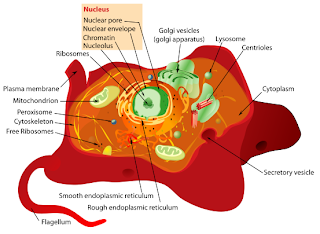ANIMAL CELL ANATOMY
-Cell membrane : the thin layer of protein and fat that surrounds the cell.
-Centrosome: a small body located near the nucleus - it has a dense center and radiating tubules. The centrosomes is where microtubules are made.
-Cytoplasm: the jellylike material outside the cell nucleus in which the organelles are located.
-Golgi body : a flattened, layered, sac-like organelle that looks like a stack of pancakes and is located near the nucleus.
-Lysosome : round organelles surrounded by a membrane and containing digestive enzymes.
-Mitochondrion: spherical to rod-shaped organelles with a double membrane.
-Nuclear membrane: the membrane that surrounds the nucleus.
-Nucleolus: an organelle within the nucleus - it is where ribosomal RNA is produced.
-Nucleus: spherical body containing many organelles, including the nucleolus.
-Ribosome: small organelles composed of RNA-rich cytoplasmic granules that are sites of protein synthesis.
-Rough endoplasmic reticulum: a vast system of interconnected, membranous, infolded and convoluted sacks that are located in the cell's cytoplasm.
-Smooth endoplasmic reticulum: a vast system of interconnected, membranous, infolded and convoluted tubes that are located in the cell's cytoplasm.
-Vacuole: fluid-filled, membrane-surrounded cavities inside a cell.











